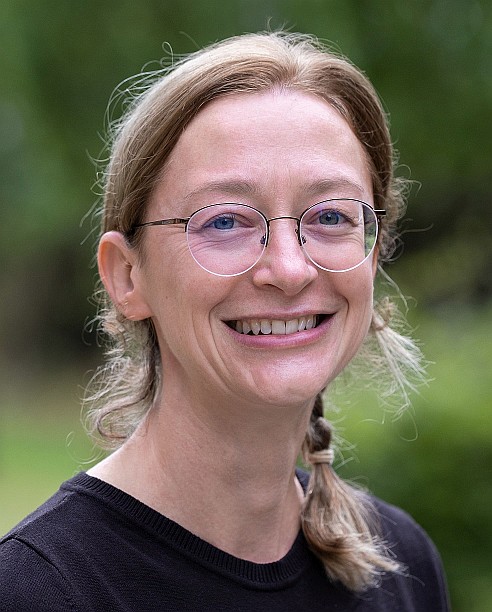B04Nipah virus replication in respiratory epithelial cells
Andrea Maisner
Prof. Dr. Andrea Maisner
Institut für Virologie
Philipps-Universität Marburg
Hans-Meerwein-Str. 2
35043 Marburg
Phone: 06421-28 65360
E-Mail: maisner(at)staff.uni-marburg(dot)de
The Malaysian Nipah virus (NiV) strain, a BSL-4 classified zoonotic paramyxovirus, emerged for the first time in 1998 and caused clinical diseases in pigs, which spread the infection to humans. While pigs developed an acute respiratory disease due to a highly efficient virus replication and associated inflammation processes in the airway epithelium, humans developed severe encephalitis with limited respiratory symptoms and little virus shedding via respiratory secretions. These differences in the clinical symptoms suggest species-specific differences in the infection of respiratory epithelial cells. Aiming to identify relevant host factors, we compared NiV infection in primary airway cultures of both species in terms of virus replication efficiencies and innate immune responses. A major finding was that NiV infections resulted in the expression of type III interferons (IFN-λ) in cells of both species with substantial quantitative differences. IFN induction was much lower in porcine airway cells, indicating an inherently limited IFN response. Surprisingly, the expression of proinflammatory cytokines (IL-6, IL-8) was not decreased in porcine epithelia. To evaluate the model that limited antiviral activity in porcine airway cells in the presence of a functional proinflammatory cytokine response is one of the species-specific factors contributing to the differences in NiV replication and virus-induced inflammatory processes, we will investigate the underlying signaling pathways in porcine and human airway epithelia. Here, we will focus on IFN-dependent and -independent expression of antiviral genes and proinflammatory cytokines in infected and uninfected bystander cells. The second part of the project is based on our recent findings that NiV not only forms cytosolic inclusion bodies (IBs), as is typical for all mononegaviruses, but additionally builds inclusions at the plasma membrane. Since the functional role of the two different types of inclusions in airway epithelia is still unknown, we will investigate their role in triggering or counteracting innate immune responses.
Project-related publications of the investigator:- Becker N, Heiner A, & Maisner A. 2022. Cytosolic Nipah Virus Inclusion Bodies Recruit Proteins Without Using Canonical Aggresome Pathways. Front. Virol. 1:821004.
- Ringel M, Behner L, Heiner A, Sauerhering L, Maisner A. 2020. Replication of a Nipah Virus Encoding a Nuclear-Retained Matrix Protein. J Infect Dis 221:S389-S394.
- Elvert M, Sauerhering L, Maisner A. 2020. Cytokine Induction in Nipah Virus-Infected Primary Human and Porcine Bronchial Epithelial Cells. J Infect Dis 221:S395-S400.
- Ringel M, Heiner A, Behner L, Halwe S, Sauerhering L, Becker N, Dietzel E, Sawatsky B, Kolesnikova L, Maisner A. 2019. Nipah virus induces two inclusion body populations: Identification of novel inclusions at the plasma membrane. PLoS Pathog 15:e1007733.
- Hoffmann M, Nehlmeier I, Brinkmann C, Krahling V, Behner L, Moldenhauer AS, Kruger N, Nehls J, Schindler M, Hoenen T, Maisner A, Becker S, Pohlmann S. 2019. Tetherin Inhibits Nipah Virus but Not Ebola Virus Replication in Fruit Bat Cells. J Virol 93.
- Behner L, Zimmermann L, Ringel M, Weis M, Maisner A. 2018. Formation of high-order oligomers is required for functional bioactivity of an African bat henipavirus surface glycoprotein. Vet Microbiol 218:90-97.
- Sauerhering L, Muller H, Behner L, Elvert M, Fehling SK, Strecker T, Maisner A. 2017. Variability of interferon-lambda induction and antiviral activity in Nipah virus infected differentiated human bronchial epithelial cells of two human donors. J Gen Virol 98:2447-2453.
- Sauerhering L, Zickler M, Elvert M, Behner L, Matrosovich T, Erbar S, Matrosovich M, Maisner A. 2016. Species-specific and individual differences in Nipah virus replication in porcine and human airway epithelial cells. J Gen Virol 97:1511-1519.
B05Lassa virus: host cell tropism and molecular pathogenesis
Thomas Strecker
Dr. Thomas Strecker
Institut für Virologie
Philipps-Universität Marburg
Hans-Meerwein-Str. 2
35043 Marburg
Phone: 06421-28 65182
E-Mail:
strecker(at)staff.uni-marburg(dot)de
Lassa virus (LASV) is a zoonotic, hemorrhagic fever-causing virus that is endemic to West Africa. Approved vaccines or specific antiviral drugs suitable to combat these infections are not available. The primary transmission route of LASV from its reservoir host to humans involves direct exposure to virus-containing rodent excretions. Although the initial infection involves the respiratory tract through inhalation of contaminated dust or fomites, information on LASV infection of human respiratory epithelial cells is limited. In the current funding period, the Strecker group observed that LASV infects polarized bronchial epithelial cells via the apical or basolateral side, while progeny virus particles are released predominantly from the apical surface. Goblet cells and basal cells were identified as initial LASV target cells in a primary human bronchial epithelial cell culture model. Together with collaborators, the Strecker group also solved the three-dimensional architecture of LASV virions and the spike envelope glycoprotein using high-resolution electron cryomicroscopy and tomography techniques.
Project-related publications of the investigator:- Thom R, Tipton T, Strecker T, Hall Y, Akoi Bore J, Maes P, Raymond Koundouno F, Fehling SK, Krahling V, Steeds K, Varghese A, Bailey G, Matheson M, Kouyate S, Cone M, Moussa Keita B, Kouyate S, Richard Ablam A, Laenen L, Vergote V, Guiver M, Timothy J, Atkinson B, Ottowell L, Richards KS, Bosworth A, Longet S, Mellors J, Pannetier D, Duraffour S, Munoz-Fontela C, Sow O, Koivogui L, Newman E, Becker S, Sprecher A, Raoul H, Hiscox J, Henao-Restrepo AM, Sakoba K, Magassouba N, Gunther S, Kader Konde M, Carroll MW. 2021. Longitudinal antibody and T cell responses in Ebola virus disease survivors and contacts: an observational cohort study. Lancet Infect Dis 21:507-516.
- Olayemi A, Adesina AS, Strecker T, Magassouba N, Fichet-Calvet E. 2020. Determining Ancestry between Rodent- and Human-Derived Virus Sequences in Endemic Foci: Towards a More Integral Molecular Epidemiology of Lassa Fever within West Africa. Biology (Basel) 9.
- Muller H, Fehling SK, Dorna J, Urbanowicz RA, Oestereich L, Krebs Y, Kolesnikova L, Schauflinger M, Krahling V, Magassouba N, Fichet-Calvet E, Ball JK, Kaufmann A, Bauer S, Becker S, von Messling V, Strecker T. 2020. Adjuvant formulated virus-like particles expressing native-like forms of the Lassa virus envelope surface glycoprotein are immunogenic and induce antibodies with broadly neutralizing activity. NPJ Vaccines 5:71.
- Blok AJ, Gurnani P, Xenopoulos A, Burroughs L, Duncan J, Urbanowicz RA, Tsoleridis T, Muller-Krauter H, Strecker T, Ball JK, Alexander C, Alexander MR. 2020. Polymer microarrays rapidly identify competitive adsorbents of virus-like particles. Biointerphases 15:061005.
- Timothy JWS, Hall Y, Akoi-Bore J, Diallo B, Tipton TRW, Bower H, Strecker T, Glynn JR, Carroll MW. 2019. Early transmission and case fatality of Ebola virus at the index site of the 2013-16 west African Ebola outbreak: a cross-sectional seroprevalence survey. Lancet Infect Dis 19:429-438.
- Whitmer SLM, Strecker T, Cadar D, Dienes HP, Faber K, Patel K, Brown SM, Davis WG, Klena JD, Rollin PE, Schmidt-Chanasit J, Fichet-Calvet E, Noack B, Emmerich P, Rieger T, Wolff S, Fehling SK, Eickmann M, Mengel JP, Schultze T, Hain T, Ampofo W, Bonney K, Aryeequaye JND, Ribner B, Varkey JB, Mehta AK, Lyon GM, 3rd, Kann G, De Leuw P, Schuettfort G, Stephan C, Wieland U, Fries JWU, Kochanek M, Kraft CS, Wolf T, Nichol ST, Becker S, Stroher U, Gunther S. 2018. New Lineage of Lassa Virus, Togo, 2016. Emerg Infect Dis 24:599-602.
- Watanabe Y, Raghwani J, Allen JD, Seabright GE, Li S, Moser F, Huiskonen JT, Strecker T, Bowden TA, Crispin M. 2018. Structure of the Lassa virus glycan shield provides a model for immunological resistance. Proc Natl Acad Sci U S A 115:7320-7325.
- Sauerhering L, Muller H, Behner L, Elvert M, Fehling SK, Strecker T, Maisner A. 2017. Variability of interferon-lambda induction and antiviral activity in Nipah virus infected differentiated human bronchial epithelial cells of two human donors. J Gen Virol 98:2447-2453.
- Huber M, Suprunenko T, Ashhurst T, Marbach F, Raifer H, Wolff S, Strecker T, Viengkhou B, Jung SR, Obermann HL, Bauer S, Xu HC, Lang PA, Tom A, Lang KS, King NJC, Campbell IL, Hofer MJ. 2017. IRF9 Prevents CD8(+) T Cell Exhaustion in an Extrinsic Manner during Acute Lymphocytic Choriomeningitis Virus Infection. J Virol 91.
B06Functional comparison of the NSs virulence factors from the genus Phlebovirus
Friedemann Weber
Prof. Dr. Friedemann Weber
Institut für Virologie
FB Veterinärmedizin
Justus-Liebig-Universität Gießen
Schubertstraße 81
35392 Gießen
Phone: 0641-99 38350
E-mail: friedemann.weber(at)vetmed.uni-giessen(dot)de
The genus Phlebovirus (family Phenuiviridae, order Bunyavirales) contains virus species covering a wide spectrum of virulence. Rift Valley fever virus (RVFV) is highly pathogenic representative, whereas the Sandfly fever Sicilian virus (SFSV) displays an intermediate level of virulence. Although the importance of phleboviruses is increasingly recognized, we are only beginning to understand the mechanisms of pathogenicity. A key virulence factor of phleboviruses is the non-structural protein NSs, an inhibitor of the antiviral type I interferon (IFN) system. In the previous two funding periods, the Weber group identified the mechanisms by which the NSs proteins of both RVFV and SFSV inhibit the transactivation of the IFN genes and abrogate the antiviral protein kinase R (PKR) pathway. For RVFV, the NSs was found to recruit several E3 ubiquitin ligases of the F-Box type in order to destroy the general host cell transcription factor TF-IIH and the antiviral mRNA translation inhibitor PKR. SFSV NSs, by contrast, is occluding the DNA-binding domain of the IFN transcription factor IRF-3 to inhibit IFN induction, and also binds to the translation initiation factor eIF2B to protect the ribosomal machinery against the inhibitory PKR signaling. Expectedly, phleboviruses with a deleted NSs gene are strong activators of the IFN system. Using an NSs-deleted RVFV, the viral panhandle was identified the main trigger of IFN induction, RIG-I as its cytoplasmic sensor, and the full set of upregulated innate immunity genes was characterized by transcriptome analysis.
Project-related publications of the investigator:- Wuerth JD, Weber F. 2022. Shielding the mRNA-translation factor eIF2B from inhibitory p-eIF2 as a viral strategy to evade protein kinase R-mediated innate immunity. Curr Opin Immunol 78:102251.
- Shalamova L, Felgenhauer U, Wilhelm J, Schaubmar AR, Buettner K, Schoen A, Widera M, Ciesek S, Weber F. 2022. Omicron variant of SARS-CoV-2 exhibits an increased resilience to the antiviral type I interferon response. PNAS Nexus 1:67.
- Hufsky F, Beslic D, Boeckaerts D, Duchene S, Gonzalez-Tortuero E, Gruber AJ, Guo J, Jansen D, Juma J, Kongkitimanon K, Luque A, Ritsch M, Lencioni Lovate G, Nishimura L, Pas C, Domingo E, Hodcroft E, Lemey P, Sullivan MB, Weber F, Gonzalez-Candelas F, Krautwurst S, Perez-Cataluna A, Randazzo W, Sanchez G, Marz M. 2022. The International Virus Bioinformatics Meeting 2022. Viruses 14.
- Hollidge BS, Salzano MV, Ibrahim JM, Fraser JW, Wagner V, Leitner NE, Weiss SR, Weber F, Gonzalez-Scarano F, Soldan SS. 2022. Targeted Mutations in the Fusion Peptide Region of La Crosse Virus Attenuate Neuroinvasion and Confer Protection against Encephalitis. Viruses 14.
- Wuerth JD, Weber F. 2021. NSs of the mildly virulent sandfly fever Sicilian virus is unable to inhibit interferon signaling and upregulation of interferon-stimulated genes. J Gen Virol 102.
- Kashiwagi K, Shichino Y, Osaki T, Sakamoto A, Nishimoto M, Takahashi M, Mito M, Weber F, Ikeuchi Y, Iwasaki S, Ito T. 2021. eIF2B-capturing viral protein NSs suppresses the integrated stress response. Nat Commun 12:7102.
- Borrego B, Moreno S, de la Losa N, Weber F, Brun A. 2021. The Change P82L in the Rift Valley Fever Virus NSs Protein Confers Attenuation in Mice. Viruses 13.
- Wuerth JD, Habjan M, Kainulainen M, Berisha B, Bertheloot D, Superti-Furga G, Pichlmair A, Weber F. 2020. eIF2B as a Target for Viral Evasion of PKR-Mediated Translation Inhibition. mBio 11.
- Schoen A, Lau S, Verbruggen P, Weber F. 2020. Elongin C Contributes to RNA Polymerase II Degradation by the Interferon Antagonist NSs of La Crosse Orthobunyavirus. J Virol 94.
- Lau S, Weber F. 2020. Nuclear pore protein Nup98 is involved in replication of Rift Valley fever virus and nuclear import of virulence factor NSs. J Gen Virol 101:712-716.
- Barr, JD, Weber F., Schmaljohn CS. 2020. Bunyaviruses. Chapter 17, Fields Virology, 7th edition. Lippincott Williams & Wilkins – Philadelphia, USA.
- Wuerth JD, Weber F. 2019. Ferreting out viral pathogenesis. Nat Microbiol 4:384-385.
- Jones R, Lessoued S, Meier K, Devignot S, Barata-Garcia S, Mate M, Bragagnolo G, Weber F, Rosenthal M, Reguera J. 2019. Structure and function of the Toscana virus cap-snatching endonuclease. Nucleic Acids Res 47:10914-10930.
- Holzer M, Schoen A, Wulle J, Muller MA, Drosten C, Marz M, Weber F. 2019. Virus- and Interferon Alpha-Induced Transcriptomes of Cells from the Microbat Myotis daubentonii. iScience 19:647-661.
- Frantz R, Teubner L, Schultze T, La Pietra L, Muller C, Gwozdzinski K, Pillich H, Hain T, Weber-Gerlach M, Panagiotidis GD, Mostafa A, Weber F, Rohde M, Pleschka S, Chakraborty T, Abu Mraheil M. 2019. The secRNome of Listeria monocytogenes Harbors Small Noncoding RNAs That Are Potent Inducers of Beta Interferon. mBio 10.
- Wuerth JD, Habjan M, Wulle J, Superti-Furga G, Pichlmair A, Weber F. 2018. NSs Protein of Sandfly Fever Sicilian Phlebovirus Counteracts Interferon (IFN) Induction by Masking the DNA-Binding Domain of IFN Regulatory Factor 3. J Virol 92.
- Kiening M, Weber F, Frishman D. 2017. Conserved RNA structures in the intergenic regions of ambisense viruses. Sci Rep 7:16625.
- Ferron F, Weber F, de la Torre JC, Reguera J. 2017. Transcription and replication mechanisms of Bunyaviridae and Arenaviridae L proteins. Virus Res 234:118-134.
B07The protease specificity of influenza virus hemagglutinin and coronavirus spike protein with monobasic cleavage site: underlying mechanisms and host proteases involved
Eva Böttcher-Friebertshäuser
Prof. Dr. Eva Böttcher-Friebertshäuser
Institut für Virologie
Philipps-Universität Marburg
Hans-Meerwein-Str. 2
35043 Marburg
Phone: 06421-28 66019
E-mail: friebertshaeuser(at)staff.uni-marburg(dot)de
Proteolytic activation of enveloped viruses including influenza A and B virus (IAV/IBV) and coronaviruses (CoV) by host cell proteases is crucial for virus infectivity. We previously demonstrated in vitro that the transmembrane serine protease 2 (TMPRSS2) cleaves influenza virus hemagglutinin possessing a monobasic cleavage site. Further studies by us and others revealed that TMPRSS2 is capable of activating many respiratory viruses. Recently, we identified TMPRSS2 as major activating protease of IAV of almost all 16 HA-subtypes in human and murine airway cells and of IBV in human lung. Having established the crucial role of TMPRSS2 in influenza virus activation in lower human airways we now want to validate its role in IAV/IBV activation in the human upper respiratory tract. Furthermore, we aim at investigating the tissue distribution and role of TMPRSS2 orthologues in IAV activation in chicken and ducks that are important IAV hosts.
Project-related publications of the investigator:- Bestle D, Limburg H, Kruhl D, Harbig A, Stein DA, Moulton H, Matrosovich M, Abdelwhab EM, Stech J, Bottcher-Friebertshauser E. 2021. Hemagglutinins of Avian Influenza Viruses Are Proteolytically Activated by TMPRSS2 in Human and Murine Airway Cells. J Virol 95:e0090621.
- Harbig A, Mernberger M, Bittel L, Pleschka S, Schughart K, Steinmetzer T, Stiewe T, Nist A, Bottcher-Friebertshauser E. 2020. Transcriptome profiling and protease inhibition experiments identify proteases that activate H3N2 influenza A and influenza B viruses in murine airways. J Biol Chem 295:11388-11407.
- Bestle D, Heindl MR, Limburg H, Van Lam van T, Pilgram O, Moulton H, Stein DA, Hardes K, Eickmann M, Dolnik O, Rohde C, Klenk HD, Garten W, Steinmetzer T, Bottcher-Friebertshauser E. 2020. TMPRSS2 and furin are both essential for proteolytic activation of SARS-CoV-2 in human airway cells. Life Sci Alliance 3.
- Limburg H, Harbig A, Bestle D, Stein DA, Moulton HM, Jaeger J, Janga H, Hardes K, Koepke J, Schulte L, Koczulla AR, Schmeck B, Klenk HD, Bottcher-Friebertshauser E. 2019. TMPRSS2 Is the Major Activating Protease of Influenza A Virus in Primary Human Airway Cells and Influenza B Virus in Human Type II Pneumocytes. J Virol 93.
- Bottcher-Friebertshauser E. 2018. Membrane-Anchored Serine Proteases: Host Cell Factors in Proteolytic Activation of Viral Glycoproteins. In: Böttcher-Friebertshäuser E., Garten W., Klenk H. (eds) Activation of Viruses by Host Proteases. Springer, Cham, p.153-203.
- Tarnow C, Engels G, Arendt A, Schwalm F, Sediri H, Preuss A, Nelson PS, Garten W, Klenk HD, Gabriel G, Bottcher-Friebertshauser E. 2014. TMPRSS2 is a host factor that is essential for pneumotropism and pathogenicity of H7N9 influenza A virus in mice. J Virol 88:4744-51.
- Baron J, Tarnow C, Mayoli-Nussle D, Schilling E, Meyer D, Hammami M, Schwalm F, Steinmetzer T, Guan Y, Garten W, Klenk HD, Bottcher-Friebertshauser E. 2013. Matriptase, HAT, and TMPRSS2 activate the hemagglutinin of H9N2 influenza A viruses. J Virol 87:1811-20.
- Bottcher-Friebertshauser E, Lu Y, Meyer D, Sielaff F, Steinmetzer T, Klenk HD, Garten W. 2012. Hemagglutinin activating host cell proteases provide promising drug targets for the treatment of influenza A and B virus infections. Vaccine 30:7374-80.
- Bottcher-Friebertshauser E, Stein DA, Klenk HD, Garten W. 2011. Inhibition of influenza virus infection in human airway cell cultures by an antisense peptide-conjugated morpholino oligomer targeting the hemagglutinin-activating protease TMPRSS2. J Virol 85:1554-62.
- Bottcher-Friebertshauser E, Freuer C, Sielaff F, Schmidt S, Eickmann M, Uhlendorff J, Steinmetzer T, Klenk HD, Garten W. 2010. Cleavage of influenza virus hemagglutinin by airway proteases TMPRSS2 and HAT differs in subcellular localization and susceptibility to protease inhibitors. J Virol 84:5605-14.
- Bottcher E, Matrosovich T, Beyerle M, Klenk HD, Garten W, Matrosovich M. 2006. Proteolytic activation of influenza viruses by serine proteases TMPRSS2 and HAT from human airway epithelium. J Virol 80:9896-8.
B08Structural and functional factors determining entry and replication of hepatitis D and B viruses during co-infection
Dieter Glebe, Joachim Geyer
Prof. Dr. Dieter Glebe
Institut für Medizinische Virologie
Justus-Liebig-Universität Gießen
Schubertstraße 81
35392 Gießen
Phone: 0641-99 41246
E-Mail:
dieter.glebe(at)viro.med.uni-giessen(dot)de
Prof. Dr. Joachim Geyer
Institut für Pharmakologie und Toxikologie
Justus-Liebig-Universität Gießen
Schubertstraße 81
35392 Gießen
Phone: 0641-99 38404
E-Mail:
joachim.m.geyer(at)vetmed.uni-giessen(dot)de
Human hepatitis D virus (HDV) is a small defective RNA-virus that is dependent on the presence of hepatitis B virus (HBV) as a helper virus in coinfected patients. Both viruses infect hepatocytes within the liver via blood and sexual contacts and can cause acute and chronic liver disease resulting in liver cirrhosis and liver cancer. Worldwide, at least 12 million people are chronically infected with HDV with limited therapeutic options available. The completion of the full HDV replication cycle is dependent on a helper virus and cellular host factors within co-infected hepatocytes. Since HDV uses HBV surface proteins (HBsAg) for envelopment, budding and secretion of virions into the blood, both viruses are supposed to use comparable entry pathways for infection. The liver-specific bile acid transporter (NTCP) was discovered in 2012 as high-affinity HBV/HDV receptor and was first confirmed to be essential for HDV infection in 2013 by the principal investigators of this proposal. Our establishment of highly susceptible human hepatoma cells stably expressing NTCP at physiological levels enabled us to study viral binding, entry and replication of HDV and HBV at the cellular level. In addition to NTCP, other cellular cofactors appear to be involved in the quantitative regulation of virus entry via NTCP, but these have not yet been fully identified and characterized. Recently, interaction of HDV with envelope proteins of other coinfecting hepatotropic viruses, e.g. hepatitis C virus (HCV), has been demonstrated, suggesting that HDV might alter its infection pattern by switching viral surface proteins. Besides human HDV, HDV-like viruses have recently been found in other vertebrates (e.g. snakes, birds). In this context, we have isolated the first non-human mammalian HDV isolate from rodents, which is closely related to human HDV with robust replication in human liver cells, but its replication pattern has not yet been characterized. During the next funding period, we will (i) identify and analyze cellular NTCP cofactors defining viral binding and entry, (ii) characterize structural determinants of the overlapping virus/substrate binding domains of NTCP, (iii) compare replication of HDV with phylogenetically related animal HDV, and (iv) analyze determinants of HDV packaging upon coinfection with other hepatotropic viruses (HBV/HCV).
Project-related publications of the investigators:- Rasche A, Lehmann F, Goldmann N, Nagel M, Moreira-Soto A, Nobach D, de Oliveira Carneiro I, Osterrieder N, Greenwood AD, Steinmann E, Lukashev AN, Schuler G, Glebe D, Drexler JF, Equid HBVC. 2021. A hepatitis B virus causes chronic infections in equids worldwide. Proc Natl Acad Sci U S A 118.
- Pfluger LS, Norz D, Volz T, Giersch K, Giese A, Goldmann N, Glebe D, Bockmann JH, Pfefferle S, Dandri M, Schulze Zur Wiesch J, Lutgehetmann M. 2021. Clinical establishment of a laboratory developed quantitative HDV PCR assay on the cobas6800 high-throughput system. JHEP Rep 3:100356.
- Pfefferkorn M, Schott T, Bohm S, Deichsel D, Felkel C, Gerlich WH, Glebe D, Wat C, Pavlovic V, Heyne R, Berg T, van Bommel F. 2021. Composition of HBsAg is predictive of HBsAg loss during treatment in patients with HBeAg-positive chronic hepatitis B. J Hepatol 74:283-292.
- Palatini M, Muller SF, Lowjaga K, Noppes S, Alber J, Lehmann F, Goldmann N, Glebe D, Geyer J. 2021. Mutational Analysis of the GXXXG/A Motifs in the Human Na(+)/Taurocholate Co-Transporting Polypeptide NTCP on Its Bile Acid Transport Function and Hepatitis B/D Virus Receptor Function. Front Mol Biosci 8:699443.
- Lowjaga K, Kirstgen M, Muller SF, Goldmann N, Lehmann F, Glebe D, Geyer J. 2021. Long-term trans-inhibition of the hepatitis B and D virus receptor NTCP by taurolithocholic acid. Am J Physiol Gastrointest Liver Physiol 320:G66-G80.
- Kirstgen M, Muller SF, Lowjaga K, Goldmann N, Lehmann F, Alakurtti S, Yli-Kauhaluoma J, Baringhaus KH, Krieg R, Glebe D, Geyer J. 2021. Identification of Novel HBV/HDV Entry Inhibitors by Pharmacophore- and QSAR-Guided Virtual Screening. Viruses 13.
- Kirstgen M, Lowjaga K, Muller SF, Goldmann N, Lehmann F, Glebe D, Baringhaus KH, Geyer J. 2021. Hepatitis D Virus Entry Inhibitors Based on Repurposing Intestinal Bile Acid Reabsorption Inhibitors. Viruses 13.
- Grosser G, Muller SF, Kirstgen M, Doring B, Geyer J. 2021. Substrate Specificities and Inhibition Pattern of the Solute Carrier Family 10 Members NTCP, ASBT and SOAT. Front Mol Biosci 8:689757.
- Glebe D, Goldmann N, Lauber C, Seitz S. 2021. HBV evolution and genetic variability: Impact on prevention, treatment and development of antivirals. Antiviral Res 186:104973.
- Paraskevopoulou S, Pirzer F, Goldmann N, Schmid J, Corman VM, Gottula LT, Schroeder S, Rasche A, Muth D, Drexler JF, Heni AC, Eibner GJ, Page RA, Jones TC, Muller MA, Sommer S, Glebe D, Drosten C. 2020. Mammalian deltavirus without hepadnavirus coinfection in the neotropical rodent Proechimys semispinosus. Proc Natl Acad Sci U S A 117:17977-17983.
- Kirstgen M, Lowjaga K, Muller SF, Goldmann N, Lehmann F, Alakurtti S, Yli-Kauhaluoma J, Glebe D, Geyer J. 2020. Selective hepatitis B and D virus entry inhibitors from the group of pentacyclic lupane-type betulin-derived triterpenoids. Sci Rep 10:21772.
- Jensen O, Ansari S, Gebauer L, Muller SF, Lowjaga K, Geyer J, Tzvetkov MV, Brockmoller J. 2020. A double-Flp-in method for stable overexpression of two genes. Sci Rep 10:14018.
- Rasche A, Lehmann F, Konig A, Goldmann N, Corman VM, Moreira-Soto A, Geipel A, van Riel D, Vakulenko YA, Sander AL, Niekamp H, Kepper R, Schlegel M, Akoua-Koffi C, Souza B, Sahr F, Olayemi A, Schulze V, Petraityte-Burneikiene R, Kazaks A, Lowjaga K, Geyer J, Kuiken T, Drosten C, Lukashev AN, Fichet-Calvet E, Ulrich RG, Glebe D, Drexler JF. 2019. Highly diversified shrew hepatitis B viruses corroborate ancient origins and divergent infection patterns of mammalian hepadnaviruses. Proc Natl Acad Sci U S A 116:17007-17012.
- Noppes S, Muller SF, Bennien J, Holtemeyer M, Palatini M, Leidolf R, Alber J, Geyer J. 2019. Homo- and heterodimerization is a common feature of the solute carrier family SLC10 members. Biol Chem 400:1371-1384.
- Gerresheim GK, Bathke J, Michel AM, Andreev DE, Shalamova LA, Rossbach O, Hu P, Glebe D, Fricke M, Marz M, Goesmann A, Kiniry SJ, Baranov PV, Shatsky IN, Niepmann M. 2019. Cellular Gene Expression during Hepatitis C Virus Replication as Revealed by Ribosome Profiling. Int J Mol Sci 20.
- Pfefferkorn M, Bohm S, Schott T, Deichsel D, Bremer CM, Schroder K, Gerlich WH, Glebe D, Berg T, van Bommel F. 2018. Quantification of large and middle proteins of hepatitis B virus surface antigen (HBsAg) as a novel tool for the identification of inactive HBV carriers. Gut 67:2045-2053.
- Nielsen KO, Mirza AH, Kaur S, Jacobsen KS, Winther TN, Glebe D, Pociot F, Hogh B, Storling J. 2018. Hepatitis B virus suppresses the secretion of insulin-like growth factor binding protein 1 to facilitate anti-apoptotic IGF-1 effects in HepG2 cells. Exp Cell Res 370:399-408.
- Muller SF, Konig A, Doring B, Glebe D, Geyer J. 2018. Characterisation of the hepatitis B virus cross-species transmission pattern via Na+/taurocholate co-transporting polypeptides from 11 New World and Old World primate species. PLoS One 13:e0199200.
- de Carvalho Dominguez Souza BF, Konig A, Rasche A, de Oliveira Carneiro I, Stephan N, Corman VM, Roppert PL, Goldmann N, Kepper R, Muller SF, Volker C, de Souza AJS, Gomes-Gouvea MS, Moreira-Soto A, Stocker A, Nassal M, Franke CR, Rebello Pinho JR, Soares M, Geyer J, Lemey P, Drosten C, Netto EM, Glebe D, Drexler JF. 2018. A novel hepatitis B virus species discovered in capuchin monkeys sheds new light on the evolution of primate hepadnaviruses. J Hepatol 68:1114-1122.
B10Function of lipid droplets in replication and pathogenesis of neurotropic flaviviruses
Eva Herker
Prof. Dr. Eva Herker
Institut für Virologie
Philipps-Universität Marburg
Hans-Meerwein-Str. 2
35043 Marburg
Phone: 06421-28 66019
E-Mail:
eva.herker(at)staff.uni-marburg(dot)de
Viruses rely on host lipid metabolic pathways for replication. Lipid droplets are the main cellular storage organelles of neutral lipids and central hubs of lipid trafficking. The Herker group investigates the function of lipid droplets in virus infection and pathogenesis and how viruses rewire cellular metabolic pathways for successful replication. Capsid proteins from hepatitis C virus (HCV) and different flavivirus family members localize to lipid droplets and, depending on cell types and viruses, lipid droplet accumulation and degradation have been observed in infected cells. However, it is currently unknown, how neurotropic flaviviruses interact with the intricate lipid metabolism of brain cells. This project aims to i) characterize host cell lipid droplets after expression of the capsid protein C or during West Nile virus (WNV), Zika virus (ZIKV), and tick-borne encephalitis virus (TBEV) infection in different cell types, such as neuron and astrocyte cell lines, human neurons and astrocytes differentiated from stem cells, and murine primary cells, ii) determine if WNV, ZIKV, and TBEV infection is inhibited by interference with lipid droplet formation and/or lipid mobilization, and iii) elucidate if virus-induced pathogenic effects are in part due to metabolic disturbance.
Project-related publications of the investigator:- Herker E, Vieyres G, Beller M, Krahmer N, Bohnert M. 2021. Lipid Droplet Contact Sites in Health and Disease. Trends Cell Biol 31:345-358.
- Bley H, Schobel A, Herker E. 2020. Whole Lotta Lipids-from HCV RNA Replication to the Mature Viral Particle. Int J Mol Sci 21.
- Lassen S, Gruttner C, Nguyen-Dinh V, Herker E. 2019. Perilipin-2 is critical for efficient lipoprotein and hepatitis C virus particle production. J Cell Sci 132.
- Schobel A, Rosch K, Herker E. 2018. Functional innate immunity restricts Hepatitis C Virus infection in induced pluripotent stem cell-derived hepatocytes. Sci Rep 8:3893.
- Hofmann S, Krajewski M, Scherer C, Scholz V, Mordhorst V, Truschow P, Schobel A, Reimer R, Schwudke D, Herker E. 2018. Complex lipid metabolic remodeling is required for efficient hepatitis C virus replication. Biochim Biophys Acta Mol Cell Biol Lipids 1863:1041-1056.
- Rosch K, Kwiatkowski M, Hofmann S, Schobel A, Gruttner C, Wurlitzer M, Schluter H, Herker E. 2016. Quantitative Lipid Droplet Proteome Analysis Identifies Annexin A3 as a Cofactor for HCV Particle Production. Cell Rep 16:3219-3231.
- Eggert D, Rosch K, Reimer R, Herker E. 2014. Visualization and analysis of hepatitis C virus structural proteins at lipid droplets by super-resolution microscopy. PLoS One 9:e102511.
- Camus G, Schweiger M, Herker E, Harris C, Kondratowicz AS, Tsou CL, Farese RV, Jr., Herath K, Previs SF, Roddy TP, Pinto S, Zechner R, Ott M. 2014. The hepatitis C virus core protein inhibits adipose triglyceride lipase (ATGL)-mediated lipid mobilization and enhances the ATGL interaction with comparative gene identification 58 (CGI-58) and lipid droplets. J Biol Chem 289:35770-80.
- Vogt DA, Camus G, Herker E, Webster BR, Tsou CL, Greene WC, Yen TS, Ott M. 2013. Lipid droplet-binding protein TIP47 regulates hepatitis C Virus RNA replication through interaction with the viral NS5A protein. PLoS Pathog 9:e1003302.
- Camus G, Herker E, Modi AA, Haas JT, Ramage HR, Farese RV, Jr., Ott M. 2013. Diacylglycerol acyltransferase-1 localizes hepatitis C virus NS5A protein to lipid droplets and enhances NS5A interaction with the viral capsid core. J Biol Chem 288:9915-9923.
- Herker E, Ott M. 2012. Emerging role of lipid droplets in host/pathogen interactions. J Biol Chem 287:2280-7.
- Herker E, Ott M. 2011. Unique ties between hepatitis C virus replication and intracellular lipids. Trends Endocrinol Metab 22:241-8.
- Harris C, Herker E, Farese RV, Jr., Ott M. 2011. Hepatitis C virus core protein decreases lipid droplet turnover: a mechanism for core-induced steatosis. J Biol Chem 286:42615-42625.
- Herker E, Harris C, Hernandez C, Carpentier A, Kaehlcke K, Rosenberg AR, Farese RV, Jr., Ott M. 2010. Efficient hepatitis C virus particle formation requires diacylglycerol acyltransferase-1. Nat Med 16:1295-8.
B11Molecular basis for the virulence of deformed wing virus infections in honey bees
Benjamin Lamp
Prof. Dr. Benjamin Lamp
Institut für Virologie
FB Veterinärmedizin
Justus-Liebig-Universität Gießen
Schubertstraße 81
35392 Gießen
Phone: 0641-99 38356
E-mail: Benjamin.J.Lamp(at)vetmed.uni-giessen(dot)de
The Deformed wing virus (DWV; order Picornavirales) is a major pathogen of honey bees (Apis mellifera) and responsible for colony collapses. It is hypothesized that virulent emerging DWV strains have evolved from less virulent precursors. In this funding period, we want to decipher the molecular determinants of DWV virulence using combined molecular biological and protein biochemical approaches. Molecular markers of DWV virulence will be elucidated by studying (I) inter-strain recombination, (II) in vivo passaging and adaptation of DWV-B, and (III) the role of the viral leader protein as potential RNAi escape factor. An avirulent DWV-B will be used as a platform to localize the genomic regions responsible for virulence. (I) The series of genetically engineered DWV recombinants will be systematically studied for replication, viral titers, host cell range and virulence in honey bee pupae and primary bee cells. (II) We will passage a DWV-B clone in vivo to study virulence emergence. Responsible mutations will be characterized using reverse genetics. (III) We hypothesize that the leader protein of DWV is an antagonist of the innate immune defense of honey bees and hence a central virulence factor. We will characterize the leader protein of DWV using reporter assays, recombinant cell culture expression, and pull-down experiments to identify the interacting host cell factors. Hopefully, our results will contribute to the establishment of new concepts against the devastating colony losses in beekeeping.
Project-related publications of the investigator:- Seitz K, Buczolich K, Dikunova A, Plevka P, Power K, Rumenapf T, Lamp B. 2019. A molecular clone of Chronic Bee Paralysis Virus (CBPV) causes mortality in honey bee pupae (Apis mellifera). Sci Rep 9:16274.
- Riedel C, Lamp B, Chen HW, Heimann M, Rumenapf T. 2019. Fluorophore labelled BVDV: a novel tool for the analysis of infection dynamics. Sci Rep 9:5972.
- Kiesler A, Seitz K, Schwarz L, Buczolich K, Petznek H, Sassu E, Durlinger S, Hogler S, Klang A, Riedel C, Chen HW, Motz M, Kirkland P, Weissenbock H, Ladinig A, Rumenapf T, Lamp B. 2019. Clinical and Serological Evaluation of LINDA Virus Infections in Post-Weaning Piglets. Viruses 11.
- Schwarz L, Riedel C, Hogler S, Sinn LJ, Voglmayr T, Wochtl B, Dinhopl N, Rebel-Bauder B, Weissenbock H, Ladinig A, Rumenapf T, Lamp B. 2017. Congenital infection with atypical porcine pestivirus (APPV) is associated with disease and viral persistence. Vet Res 48:1.
- Lamp B, Schwarz L, Hogler S, Riedel C, Sinn L, Rebel-Bauder B, Weissenbock H, Ladinig A, Rumenapf T. 2017. Novel Pestivirus Species in Pigs, Austria, 2015. Emerg Infect Dis 23:1176-1179.
- Schurischuster S., S. Zambanini, M. Kampel, and B. Lamp*. 2016. Sensor Study for Monitoring Varroa Mites on Honey Bees (Apis mellifera). Proceedings of the Visual observation and analysis of Vertebrate And Insect Behavior, VAIB 5:11, http://homepages.inf.ed.ac.uk/rbf/VAIB16PAPERS/vaibchurischuster.pdf
- Lamp B, Url A, Seitz K, Eichhorn J, Riedel C, Sinn LJ, Indik S, Koglberger H, Rumenapf T. 2016. Construction and Rescue of a Molecular Clone of Deformed Wing Virus (DWV). PLoS One 11:e0164639.
- Lamp B, Riedel C, Wentz E, Tortorici MA, Rumenapf T. 2013. Autocatalytic cleavage within classical swine fever virus NS3 leads to a functional separation of protease and helicase. J Virol 87:11872-83.
- Riedel C, Lamp B, Heimann M, Konig M, Blome S, Moennig V, Schuttler C, Thiel HJ, Rumenapf T. 2012. The core protein of classical Swine Fever virus is dispensable for virus propagation in vitro. PLoS Pathog 8:e1002598.
- Lamp B, Riedel C, Roman-Sosa G, Heimann M, Jacobi S, Becher P, Thiel HJ, Rumenapf T. 2011. Biosynthesis of classical swine fever virus nonstructural proteins. J Virol 85:3607-20.
B12Mechanistic insights into morbillivirus-induced immunosuppression and antiviral responses
Christian Pfaller, Bevan Sawatsky
Dr. Christian Pfaller
Paul-Ehrlich-Institut
Paul-Ehrlich-Str. 51
63225 Langen
Phone: 06103-777 442
E-mail: Christian.Pfaller(at)pei(dot)de
Dr. Bevan Sawatsky
Paul-Ehrlich-Institut
Paul-Ehrlich-Str. 51
63225 Langen
Phone: 06103-777 445
E-mail: bevan.sawatsky(at)pei(dot)de
Morbillivirus infections are a continuing threat to human and animal health. Measles virus still causes more than 140,000 fatalities annually. Canine distemper virus, the morbillivirus infecting carnivores like ferrets, is a potent surrogate model to study morbillivirus pathogenesis. Morbilliviruses cause immunosuppression, making infected individuals vulnerable to opportunistic secondary infections. They can cause loss of pre-acquired immunity, a phenomenon described as immune amnesia. Paradoxically, morbillivirus infections induce strong virus-specific humoral responses providing long-lasting immunity. Morbilliviruses infect and replicate in a subset of immune cells, including dendritic cells, macrophages, activated T cells, and naïve and activated B cells. We believe that immune amnesia is the result of depletion or functional reprogramming of infected cells, but detailed mechanistic insights remain elusive. Using the canine distemper virus/ferret-model, we are interested in investigating the interactions of morbilliviruses with immune cells to clarify how the virus changes immune organ environments and immune cell functions that consequently cause immune amnesia. We are also studying the duration and extent of immune amnesia induced by viruses exhibiting different degrees of viremia and attenuation. We try to answer important questions regarding morbillivirus biology: Which antiviral programs cause attenuation of morbilliviruses? How do they affect virus-induced immunosuppression and immune amnesia? By making use of mutant viruses expressing immunostimulatory defective-interfering RNAs we can assess their contributions to attenuation in ferrets and evaluate whether infection with immune-activating viruses can lead to productive antiviral responses that are able to protect from infection with lethal pathogenic virus. The identified mechanisms will be useful to develop novel strategies to alleviate morbillivirus-induced immunosuppression. Our findings will also allow rational design of novel, improved morbillivirus vaccines.
Project-related publications of the investigators:- Pfaller CK, Bloyet LM, Donohue RC, Huff AL, Bartemes WP, Yousaf I, Urzua E, Claviere M, Zachary M, de Masson d'Autume V, Carson S, Schieferecke AJ, Meyer AJ, Gerlier D, Cattaneo R. 2020. The C Protein Is Recruited to Measles Virus Ribonucleocapsids by the Phosphoprotein. J Virol 94.
- Ayasoufi K, Pfaller CK. 2020. Seek and hide: the manipulating interplay of measles virus with the innate immune system. Curr Opin Virol 41:18-30.
- Petrova VN, Sawatsky B, Han AX, Laksono BM, Walz L, Parker E, Pieper K, Anderson CA, de Vries RD, Lanzavecchia A, Kellam P, von Messling V, de Swart RL, Russell CA. 2019. Incomplete genetic reconstitution of B cell pools contributes to prolonged immunosuppression after measles. Sci Immunol 4.
- Donohue RC, Pfaller CK, Cattaneo R. 2019. Cyclical adaptation of measles virus quasispecies to epithelial and lymphocytic cells: To V, or not to V. PLoS Pathog 15:e1007605.
- Thakkar VD, Cox RM, Sawatsky B, da Fontoura Budaszewski R, Sourimant J, Wabbel K, Makhsous N, Greninger AL, von Messling V, Plemper RK. 2018. The Unstructured Paramyxovirus Nucleocapsid Protein Tail Domain Modulates Viral Pathogenesis through Regulation of Transcriptase Activity. J Virol 92.
- Sawatsky B, Cattaneo R, von Messling V. 2018. Canine Distemper Virus Spread and Transmission to Naive Ferrets: Selective Pressure on Signaling Lymphocyte Activation Molecule-Dependent Entry. J Virol 92.
- Pfaller CK, Donohue RC, Nersisyan S, Brodsky L, Cattaneo R. 2018. Extensive editing of cellular and viral double-stranded RNA structures accounts for innate immunity suppression and the proviral activity of ADAR1p150. PLoS Biol 16:e2006577.
- Pfaller CK, Mastorakos GM, Matchett WE, Ma X, Samuel CE, Cattaneo R. 2015. Measles Virus Defective Interfering RNAs Are Generated Frequently and Early in the Absence of C Protein and Can Be Destabilized by Adenosine Deaminase Acting on RNA-1-Like Hypermutations. J Virol 89:7735-47.
- Pfaller CK, Radeke MJ, Cattaneo R, Samuel CE. 2014. Measles virus C protein impairs production of defective copyback double-stranded viral RNA and activation of protein kinase R. J Virol 88:456-68.
- Sawatsky B, Wong XX, Hinkelmann S, Cattaneo R, von Messling V. 2012. Canine distemper virus epithelial cell infection is required for clinical disease but not for immunosuppression. J Virol 86:3658-66.














